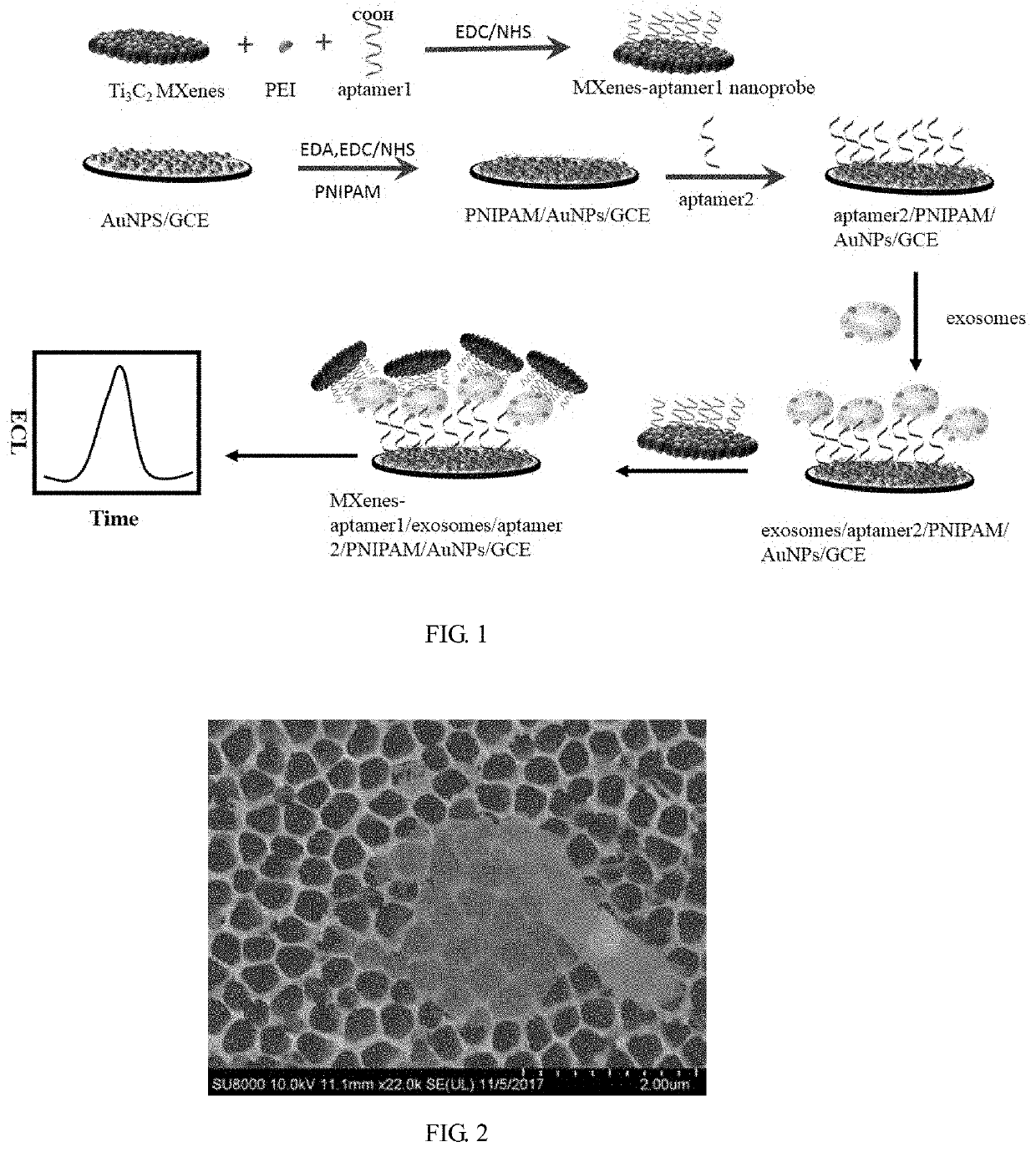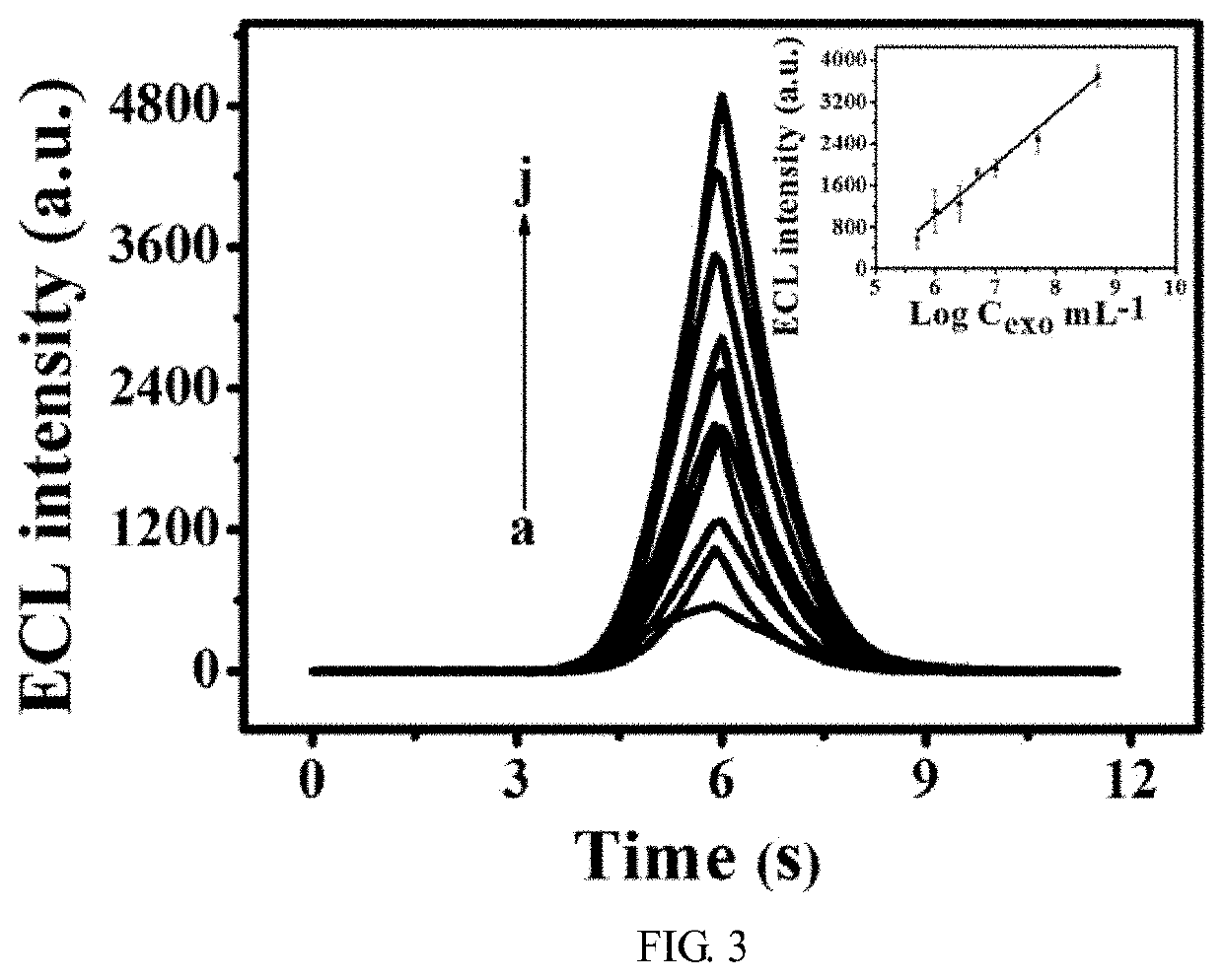Biosensor based on trititanium dicarbide two-dimensional metal carbide catalyzed luminol electrogenerated chemiluminescence probe and preparation method
- Summary
- Abstract
- Description
- Claims
- Application Information
AI Technical Summary
Benefits of technology
Problems solved by technology
Method used
Image
Examples
embodiment 1
Synthesis of MXenes-Aptamer1 Nanoprobe
[0049]Ti3AlC2 (1.0 g) powder was immersed in 15 mL of 48% (by mass) HF, and was stirred for 24 h at 45° C. Then, the suspensions were centrifuged to separate solids from the supernatant. After that the solid products were washed several times at 5000 rpm for 5 minutes each time, and were dried at room temperature. The layered Ti3C2Tx was obtained and stored at 4° C. until use The demixed Ti3C2 (0.05 g) powder was immersed in 1 mL of DMSO, stirred at room temperature for 24 h, centrifuged at 12,000 rpm and washed five times for 5 min each time, then the supernatant was discarded and DI water was added for smashing in a cell lysis instrument for 2 h. Finally, the solution was centrifuged at 3500 rpm for 60 min, and the supernatant (i.e., Ti3C2 MXenes nanosheets dispersion) was retained and stored at 4° C. for later use. Its structural characteristic is shown in FIG. 2.
[0050]200 μL of (0.005 g / mL) PEI, 3 ml Ti3C2 MXenes nanosheets and 2 mL DI water...
embodiment 2
[0057]This embodiment is the same as Embodiment 1, and the difference lies in that:
[0058]GCE after AuNPs modification: Drop 6 μL of AuNPs (18 nm) solution on pretreated GCE, the electrode was incubated to be dry at 37° C., and then the electrode was immersed in 120 μL of mixture solution containing 2 mg mL−1 EDA, 400 μM EDC and 100 μM NHS at 37° C. for 2 h. At the same time, 1 mg mL−1 carboxyl-terminated PNIPAM was activated by 400 μM EDC and 100 μM NHS at 37° C. for 1 h. The GCE incubated in the EDA was further immersed in the PNIPAM solution activated for 1 h and was incubated for 1 h. The immobilization of aptamer2 was finished by incubating the above electrode in 40 μL of 0.8 μM aptamer2 solution at 37° C. for 2 h, washed and blown dry to obtain a the electrode of the biosensor, which was recorded as aptamer2 / PNIPAM / AuNPs / GCE.
Assembly of Sensor
[0059]The aptamer2 / PNIPAM / AuNPs / GCE was immersed in exosomes with different concentrations at 25° C. for 1 h. And th...
embodiment 3
[0061]This embodiment is the same as Embodiment 1, and the difference lies in that:
[0062]GCE after AuNPs modification: Drop 6 μL of AuNPs solution on pretreated GCE, the electrode was incubated to be dry at 37° C., and then the electrode was immersed in 120 μL of mixture solution containing 2 mg mL−1 EDA, 400 μM EDC and 100 μM NHS at 37° C. for 2 h. At the same time, 1 mg mL−1 carboxyl-terminated PNIPAM was activated by 400 μM EDC and 100 μM NHS at 37° C. for 1 h. The GCE incubated in the EDA was further immersed in the PNIPAM solution activated for 1 h and was incubated for 1 h. The immobilization of aptamer2 was finished by incubating the above electrode in 40 μL of 1.2 μM aptamer2 solution at 37° C. for 1.5 h, washed and blown dry to obtain the electrode of the biosensor, which was recorded as aptamer2 / PNIPAM / AuNPs / GCE.
Assembly of Sensor
[0063]The aptamer2 / PNIPAM / AuNPs / GCE was immersed in exosomes with different concentrations at 50° C. for 30 min. And then, t...
PUM
| Property | Measurement | Unit |
|---|---|---|
| Temperature | aaaaa | aaaaa |
| Time | aaaaa | aaaaa |
Abstract
Description
Claims
Application Information
 Login to View More
Login to View More - R&D
- Intellectual Property
- Life Sciences
- Materials
- Tech Scout
- Unparalleled Data Quality
- Higher Quality Content
- 60% Fewer Hallucinations
Browse by: Latest US Patents, China's latest patents, Technical Efficacy Thesaurus, Application Domain, Technology Topic, Popular Technical Reports.
© 2025 PatSnap. All rights reserved.Legal|Privacy policy|Modern Slavery Act Transparency Statement|Sitemap|About US| Contact US: help@patsnap.com


